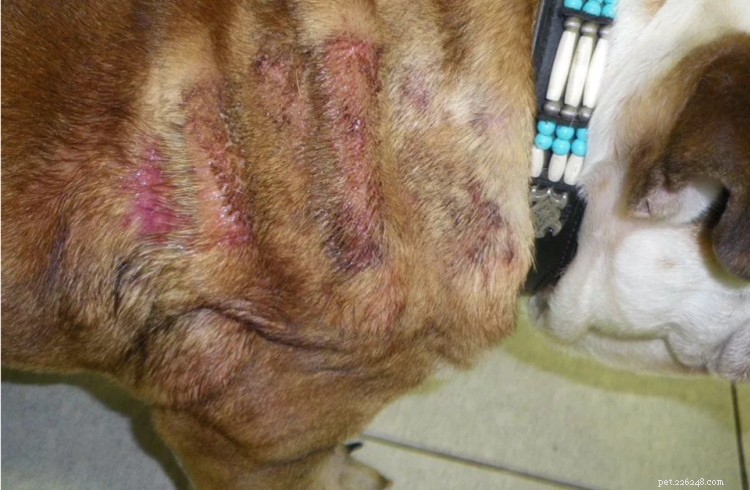Infecções fúngicas em cães:causas, tratamento e prevenção
Se o seu amigo peludo parece desconfortável ou passa muito tempo coçando e coçando o corpo, ele pode ter uma infecção por fungos. As infecções fúngicas caninas são uma condição comum que pode ocorrer em qualquer parte da pele e ser difícil de tratar.
Neste post, você aprenderá a reconhecer os sintomas da infecção por fungos em cães, como tratar a condição e como distingui-la de infecções bacterianas e reações alérgicas.
Dica profissional: Reivindicações de seguro de animais de estimação para doenças de pele tendem a custar menos do que outras doenças porque os tratamentos são menos invasivos. No entanto, seu filhote pode precisar de medicação contínua para controlar a infecção fúngica e aliviar a coceira, o que pode ser bastante caro sem uma apólice de seguro para animais de estimação que forneça cobertura para medicamentos prescritos.
- O que causa infecção por fungos em cães?
- Outras causas de coceira na pele em cães
- Infecção bacteriana da pele
- Reações alérgicas
- Quais são os sintomas da infecção por fungos em cães
- Orelhas
- Pele
- Patas
- Quais raças de cães são mais afetadas pela infecção por fungos?
- Como diagnosticar a infecção por fungos em cães?
- Como tratar a infecção por fungos em cães?
- Como prevenir infecções fúngicas em cães?
- Principais conclusões
 (Fonte da imagem:Paw Culture)
(Fonte da imagem:Paw Culture) O que causa infecção por fungos em cães?
Infecção fúngica (ou dermatite fúngica) é uma condição inflamatória da pele que ocorre comumente em cães . Organismos de levedura estão sempre presentes nos cães como parte da flora normal do corpo, mas uma infecção fúngica ocorre quando há uma quantidade excessiva de levedura em uma determinada área – geralmente nas orelhas, dobras cutâneas ou entre as almofadas das patas.
Normalmente, as infecções fúngicas em cães ocorrem devido a um problema subjacente separado. Por exemplo, é mais provável que ocorra em cachorros com sistema imunológico comprometido, alergias ambientais ou alergias alimentares – especialmente se estiverem tomando antibióticos ou esteróides.
Embora os antibióticos não causem levedura, o uso prolongado pode diminuir a presença de flora saudável que ajuda a controlar seus níveis, levando ao crescimento excessivo de levedura. Os esteróides também podem ter um efeito negativo no sistema imunológico do seu animal de estimação, o que pode permitir que a levedura cresça demais.
O clima quente ou úmido, uma infecção bacteriana e doenças de pele subjacentes, como dermatite atópica, também são fatores de risco que podem levar à infecção por fungos em cães.
Outras causas de coceira na pele em cães
Uma infecção por fungos não é a única coisa que pode fazer com que seu amigo peludo se coce mais do que o normal. Os sintomas de coceira podem sinalizar algo totalmente diferente, como:
Infecção bacteriana da pele
As infecções bacterianas da pele desencadeiam inflamações que podem fazer com que seu cão desenvolva vermelhidão, erupções cutâneas, crostas e pústulas na pele devido a toxinas produzidas por bactérias. Isso pode ocorrer se:
- A superfície da pele foi quebrada
- O sistema imunológico foi comprometido
- As bactérias normais da pele foram alteradas ou alteradas
- O fluxo sanguíneo para a pele ficou prejudicado
- A pele ficou danificada devido à exposição crônica à umidade
Carrapatos, pulgas, desequilíbrios hormonais, hereditariedade, bem como certos medicamentos também podem aumentar o risco de seu animal de estimação desenvolver uma infecção bacteriana da pele, como piodermite.
Reações alérgicas
Outra causa comum de coceira na pele em cães são as alergias. Enquanto os humanos podem espirrar durante uma reação alérgica leve, os cães tendem a sentir coceira na pele. Alergias alimentares podem se desenvolver a qualquer momento da vida, o que significa que seu filhote pode se tornar alérgico a alimentos que ele comia e apreciava regularmente.
Gatilhos ambientais, como mofo, ácaros e pólen, também podem ser responsáveis pela coceira persistente do seu cão, muitas vezes com arranhões intensificados em determinadas épocas do ano.
Pet owners will not be able to tell the difference between a yeast infection, bacterial infection, and allergic reaction at home, so the best course of action is to take your pup to the vet.
What are symptoms of yeast infection in dogs?
Only a vet can truly determine the cause behind the constant scratching, but there are a few symptoms that may provide an indication. Unlike allergic reactions and bacterial infections, yeast infection symptoms most commonly affect specific parts of the body.
Ears
Yeast infection in the ear canal is very common in canines. In most cases, there is redness, swelling, and brown discharge, accompanied by a musty or sweet smell. Ear infections are usually very itchy, causing your pooch to rub their head or scratch their ears excessively.
You may also notice other symptoms like crusted skin on the ear flap, loss of hair around the ear, head tilting or shaking, walking in circles, loss of hearing, loss of balance, and unusual eye movement.
Skin
Yeast dermatitis can occur anywhere on a dog’s skin, especially in moist skin folds, around the face and neck, where the legs meet the body, as well as on the anus and vulva.
The infected skin might be itchy, irritated, red, flaky, or greasy, and accompanied by hair loss. If the yeast infection is chronic, the dog’s skin might become thicker and darker. Yeast infections can also affect your pup’s face or mouth, in which case there will be lots of face rubbing and itching.
You might also notice hair loss on the upper back and tail, speckles on the underbelly, rust or grayish color around the genitals, and diarrhea.
Paws
Yeast infections can also affect your pet’s paws making them itchy, red, and irritated. In some cases, this is accompanied by a brown discharge in the nail beds and hair loss. The most affected part of the paws is the underside between the pads. Pups with yeast on their paws tend to lick their paws more than usual.
Which breeds are most affected?
Some dog breeds are more prone to yeast infections than others, based on their body features like many skin folds or genetics. Esses incluem:
- American Cocker Spaniels
- Australian Silky Terriers
- Basset Hounds
- Boxers
- Dachshunds
- English Setters
- Poodles
- Shih Tzus
- West Highland White Terriers
- English Bulldogs
- French Bulldogs
Ear yeast infections are more common in dogs with floppy ears, such as poodles, basset hounds, Labrador retrievers, and golden retrievers. Some breeds that have hair growing in the inner ear canal, such as Schnauzers, are also more prone to ear yeast infection.
 (Image source:The Spruce Pets)
(Image source:The Spruce Pets)
How to diagnose yeast infection in dogs
If you notice any of these symptoms, be sure to take your pet to the vet. He or she will perform cytology, i.e. take a sample from the pup’s infected skin or ear and review it under a microscope to confirm if there’s a yeast infection.
Your vet will also analyze the sample for other immune system issues because canines with yeast infections usually also have skin mites or bacterial infections.
How to treat yeast infection in dogs?
The best treatment depends on the location of the infection.
Yeast infection of the outer ear canal is usually treated with antifungal drops or ointment. An infection of the middle ear will be treated with medications (injections and tablets), although additional tests and even surgery might be necessary. Your vet might also recommend a full cleaning of the pup’s ear canal. If the infection is chronic, ask about special ear cleansers you can use at home.
Ear infections can be covered by pet insurance, but it will depend on the type of pet insurance plan you have, as well as other factors like your pup's history. If you are looking for a new insurance policy but your dog has suffered from an ear infection in the past, consider a plan that covers pre-existing conditions.
Treatments for yeast infections on the skin may include medicated shampoo, topical creams, and antifungal sprays or wipes. All these products contain ingredients effective in treating yeast infections such as ketoconazole, miconazole, and chlorhexidine.
In more severe cases, if the problem persists or appears to worsen, oral antifungal medications are also prescribed. These medications should only be used under a vet’s direction.
How to prevent yeast infections in dogs?
Yeast infections can be prevented. Besides making changes and additions to your pup’s diet, you should also consider using an antifungal shampoo. Bear in mind though that for shampoo treatment to be effective, it must sit on your pet’s skin for at least 10 minutes before rinsing.
Dogs with many skin folds might need maintenance treatment to keep these areas from becoming too moist, whereas those allergic to yeast can get an allergy vaccine.
If you suspect your four-legged pal has a yeast infection, talk to your vet for a diagnosis and treatment plan that’s appropriate for your pooch.
Principais conclusões
- Dog yeast infections are very common in skin around the ears and paws, leading to intense itching in the area.
- In most cases, dog yeast infections are easily treatable, but it's best to see your vet as soon as possible.
- Pet insurance can help cover the cost of veterinary care and prescription medication essential to making your pup feel better.
- Infecção por Bartonella em cães:sinais, causas e tratamento
- Sintomas e tratamento da actinomicose em cães
- Infecção por hera venenosa em cães - causas, diagnóstico e tratamento
- Olhos secos em cães:causas, sintomas e tratamento
- Diabetes em cães:causas, sintomas e tratamento
- Infecções de ouvido em cães:causas, sintomas e tratamento
- Pica em cães:causas, tratamento e prevenção

